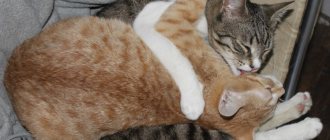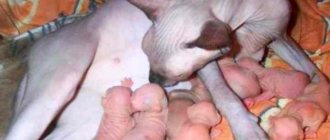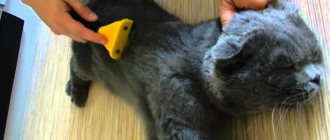The cat does not want a cat (mating problems)
Cats are mysterious and unpredictable creatures.
Each cat has its own character, its own tastes in food, choosing a place to relax, choosing partners for mating, and its own view of the world. For a breeder, the obstinate nature of a cat can be a big problem, since it jeopardizes the entire breeding work of the nursery. Unfortunately, not all cats are favorable to any proposed partner; some of them show enviable persistence in not recognizing this or that cat, refusing to mate, or suddenly going into estrus. This behavior sometimes causes a lot of difficulties for the breeder, especially if the cat has excellent characteristics for improving the breed.
What is the secret of this behavior? Is it possible to correct it and still get the long-awaited offspring? Let's try to figure out this problem.
Cats are free-living predators in nature; they are traditionally focused on improving the genes of their kittens, choosing the healthiest and strongest cat for this. In nature, a cat can refuse one cat, preferring another, or a stronger cat in a battle will win the right to mating, proving to the cat that he is the best.
In a cattery, cats don't have that choice. They are content with whoever is offered to them as a partner. In this case, the unexpected may happen: the cat refuses to mate.
There are several reasons for this behavior. For example, a cat was brought in during proestrus. In this case, estrus may not occur at all. And although the cat will react favorably to the cat and will be interested in her, the cat will not allow copulation. This situation is typical for approximately half of the cases when a cat refuses to mate.
Perhaps the cat experienced extreme stress during transportation to the cat. In this case, estrus can turn into anestrus due to the large amount of adrenaline entering the blood. In this case, the cat will show little interest, which will soon end. If estrus continues, the cat can hide for a long time, not letting the cat near her, not make contact, refuse food and water, and, ultimately, wait for the onset of metestrus and anestrus. The same reaction is observed in cats that received their first negative experience, if the first partner was an aggressive cat. In this case, the cat has experienced rape, which will greatly influence its future mating behavior.
It is also worth taking into account the biochemical processes occurring in the cat’s body that negatively affect its sexual behavior: a weakened body, low levels of estrogen and progesterone, estrus without ovulation, or drug suppression of a previous estrus.
The cat may have a negative olfactory reaction to the room; the room may not be suitable for mating. Of course, like some other mammals, cats have their own preferences in choosing partners, which are based on previous positive experience, matching colors, size of the partner, and time of adaptation.
Why won't my cat be picked up?
Contents hide
It's no secret that purring pets are bought for comfort and affection. Indeed, it is an incomparable happiness when a mustachioed pet climbs onto the owner’s lap, begins to sing his famous song and cuddle. Many cats have nothing against cuddles. You can calmly pick them up, caress them and stroke them. Moreover, the animals themselves seem to experience great pleasure.
However, there are cats in the world that cannot stand “cuddles” and other hot hugs. They will never jump on their knees. Finally, they use their teeth and claws when someone tries to pick them up. The owners are disappointed - how could this happen? Have there been any problems? Maybe we got a “special” pet? Let's figure it out.
Negative experience. It's no secret that cats are vindictive animals. They wrap their heads around literally everything. Both good and bad. Moreover, cats always quickly draw conclusions from what happened. It is possible that one of the household members handled the animal in an extremely unfortunate manner and caused pain. This was enough to form negative associations.
Natural instincts. Let's not forget that by nature cats are born hunter-predators. Despite the millennia that have passed since domestication, purrs have retained many wild habits. Let's put aside emotions and think: what self-respecting predator would put up with the way they unceremoniously grab you and start squeezing and shaking you? So there is no need to be offended: cats, in whom wild instincts turn out to be tenacious, perceive human caresses as an encroachment on their own freedom. To complete the picture, remember how your pet behaves in “normal mode”. If he spends time calmly in your company, even purrs under his side (but not in your arms) - know: he is still a semi-wild animal. And hugs are not his profile.
Self-esteem. A small example from life. You are helping a seven-year-old child get dressed. Just like that, by inertia - after all, children are always small for parents. But the seven-year-old proudly refuses help: “I’m already big.” That's right: each of us has a sense of self-worth. Cats are no exception. We can accept some help and care, but some we consider excessive care. Cats favorably accept the benefits of home life: delicious food, attention, care. But take it in your arms - excuse me. Your cat respects itself too much for this. She has grown up - in front of you is no longer a small, pliable kitten. Solution: the mustachioed pet won’t be picked up – don’t. Don't insist. Perhaps he will come to this yet, but only on his own, without outside help.
Mistrust and doubt in people. This often happens when a fairly adult pet is adopted into a home - for example, from a shelter. “Foster” and shelter animals, as a rule, have a complex and difficult past. It is difficult for them to adapt to new conditions and learn to trust previously unfamiliar people. The way out: complete freedom for the pet. Let him rest peacefully, slowly get to know the house and people. The cat will definitely choose close people whom it can trust.
Physical pain. Let's move on to the most unpleasant moment. Your pet may experience real physical pain. Cats usually skillfully disguise all their sores and illnesses, doing their best to pretend that “everything is fine.” The fragile idyll is destroyed when the owner takes the pet in his hands and inadvertently touches sore or sensitive areas. Be wary if your previously affectionate cat suddenly begins to hiss, scratch and refuse to be handled. We advise you not to wait for negative scenarios, but to immediately show the animal to a veterinarian.
Material used: Why Doesn't My Cat Like To Be Held? Source: cattitudedaily.com Photo: from open sources.
The cat doesn't give the cat what to do
Home Questions and Answers Cats Breeding cats
You really want kittens from your cat, and now she is in heat. It's time to take her to the cat. But, while visiting, instead of accepting the cat’s advances, the cat became extremely aggressive... Why? The most common reason is incorrectly chosen days for mating - i.e. the cat is just not ready yet. Usually the cat is allowed in to the cat on the 2-3rd day of estrus.
Most owners take their cat to the cat's territory, and sometimes this is very stressful for the cat, and this leads to aggression towards everyone and everything that moves. To somehow calm your cat, you can use a diffuser or Feliway spray, or give her Stop-Stress herbal drops. It is necessary to leave the animals alone for 2-3 days in an isolated room, where there is a tray and food with water. If the cat is experienced and persistent, then the mating will take place. But such a cat can be very intimidating to a young cat.
Another reason could be a health problem with the cat, so she should be examined by a veterinarian before breeding. For example, if a cat has inflamed anal glands, then during mating it becomes painful for her, and she rushes at the cat. Perhaps the cat experiences pain during estrus, which also leads to aggression on the part of the animal.
It happens that a cat simply doesn’t like a particular cat, but later she mates with others without any problems. But there are cats who never let cats near them. This indicates an incorrectly formed sexual instinct, which may be the result of problems with the ovaries or uterus.
For successful mating, animal owners and experienced felinologists recommend a variety of methods : pour a solution into a bowl or scatter mint herb; leave the cat in a cage or carrier so that it can get used to the cat and communicate with it for a couple of days; periodically take the cat out of the room “for a walk”; for an aggressive cat to look for an equally aggressive groom who will show “who’s boss”; press the cat to the floor yourself during mating; give the cat a tablespoon of Cahors (wine); injections of a drug that induce ovulation...
Be careful, it hurts the cat!
Do you know when your cat is in pain? "Certainly!" – many will rush to answer with confidence. But not everything is so simple; “seeing” a cat’s pain is not at all as easy as it might seem at first glance.
Hidden suffering
Cats hide their pain, and this is natural for them. Unlike dogs and some other animals, cats can behave quite normally in appearance, despite pain. They do not publicly demonstrate their pain, but, left alone, they begin to intensively lick the sore area.
So why do cats hide their pain? The main reason is the instinct of self-preservation. In nature, a sick or injured animal is extremely vulnerable to attack. The wild ancestors of the cat tried not to make unnecessary sounds, quickly find a safe shelter and hide there. Cats are not herd animals, unlike dogs, for whom open display of their emotions helps to gain support. The cat will hide the pain until the last moment, as long as it has the strength.
Studies have shown that when an animal experiences pain, it begins to intensively produce endorphins, which affect the emotional state and dull sensations.
Cats do not show pain in the way we are accustomed to, the way we ourselves and some other pets would. Because of this feature, veterinarians and cat owners have long mistakenly believed that cats do not experience pain at all. But this is nothing more than one of the many myths about cats.
If there is no contact and trust between a cat and its owner, it will endure and hide its problem until the last moment. Severe pain is a major biological stressor and affects numerous aspects of an animal's physical health, including wound healing and resistance to infectious disease. Studies have shown that surgical cats whose pain is controlled before and after the procedure recover much better than those whose pain was not properly addressed.
Pain varies
The pain can be acute or chronic. If it's acute, it's usually easy enough to see, because... If the circumstances under which it arose are obvious (trauma, surgery, etc.), then chronic pain is more difficult to notice: there are no obvious damage or changes in behavior. Nevertheless, chronic pain detected in time can save a cat’s life, because it is an important symptom of the disease.
The causes of acute pain can be: surgical trauma; fractures of limbs and other bones; injuries received as a result of accidents; diseases of the genitourinary system; corneal ulcers.
The most common causes of chronic pain are arthritis (osteoarthritis and degenerative joint disease) and pain associated with diseases such as cancer. The animal suffers from chronic pancreatitis (inflammation of the pancreas), chronic wounds, chronic cystitis.
In addition, animal psychologists say that cats can experience emotional pain and feelings similar to grief in humans.
Dangerous symptoms
Determining whether your cat is in pain is like playing detective: you must carefully observe and evaluate the slightest changes in your pet's behavior.
First, draw analogies with yourself. If a cat is undergoing surgery, is injured, or has a “human” disease that causes us pain, we can assume that the cat is also uncomfortable.
Secondly, pay attention to the slightest changes in your pet’s behavior. This is the first sign of pain or an incipient disease. The better you know your cat and its habits, the faster you can understand that something is wrong with it. To recognize pain, you need to know what behavior is normal for a cat: its activity level, gait, appetite, water intake, duration of sleep, sleeping position and other features.
What signs might indicate that a cat is in pain?
1. Behavior change
If a super active cat suddenly starts sleeping most of the day, this could be a sign of illness. This is also indicated, on the contrary, by the hyperactivity and restlessness of a usually calm cat.
The animal may lose interest in its favorite food and water, and its food preferences change.
The cat may become irritable and even show aggression towards other pets or people.
A sign of pain may also be a lack of desire to visit your usual favorite places. For example, a cat used to like to sit on the windowsill or on the head of the bed, but now you don’t notice it there. If she has stopped jumping as often and high as before, has difficulty climbing stairs, there has been a decrease in her motor activity in general, a change in her sleeping place to one that is easier to reach - all this is abnormal.
One of the common problems in older cats is teeth. Therefore, if your pet has become angry and gloomy, it is unlikely that it is simply due to old age. Perhaps the cat is suffering from sore teeth, and once this problem is solved, she will be as cheerful again.
2. The desire to be left alone
The cat shows in every possible way that it wants to be left alone. If she begins to growl or hiss when she is petted, touched or picked up, this is a sure sign that something is bothering her.
3. Finding a secluded place
The cat knows that pain makes it vulnerable, so it will try to hide or find a safe haven. Thus, she will be able to avoid encounters with stronger animals and not become their victim. Therefore, the animal can reduce communication with owners and other pets.
4. Sleeping too long or sleeping in one position
Pay attention to the position in which your cat sleeps. If she begins to choose one position, especially if this was not typical for her before, think about it: perhaps there is a problem behind this.
5. Licking the same area
Cats experiencing pain, in the hope of finding relief at the site of its localization, often and persistently lick the area. So, with a relapse of cystitis, cats may begin to intensively lick their belly.
6. Reluctance to take care of yourself
Being dirty and unkempt is not normal for adult animals. Cats are notoriously clean people and are great at grooming themselves. Therefore, if a pet has lost interest in its appearance, this is a reason to show it to the veterinarian.
7. Staring at nothing
Glazed and wide open eyes, especially coupled with an unnatural posture, often indicate that the animal is in great pain. The eyes in general can be an indicator of pain in a cat, regardless of whether the pain is located in the eye itself or in another part of the body. Cats in pain will have dilated pupils.
8. Changes related to the “toilet” issue and visiting the litter box
Cats with joint problems may find it painful to sit on the litter tray “as usual.” In this regard, urine may end up above the sides of the “toilet”.
9. Constant purring
A cat's purring is a means of communication and self-healing. She purrs not only to bring us joy and to show other cats that she is friendly towards them. In this way, the animal can calm down: it makes similar sounds in stressful situations, during childbirth and injury.
Various studies have shown that with the help of purring, cats are able to reduce their pain and even speed up recovery. Sound vibrations in the frequency range of rumbling promote healing and increase bone density. Your cat's constant, incessant purring is a good reason to pay attention to her.
If you notice the “suspicious” behavior of your pet described above, take it to a veterinarian for examination; do not try to diagnose the cat yourself. In addition to the fact that pain is just a symptom of the onset of a disease, be aware that many pain medications for humans are contraindicated for cats. Consult your doctor, he will prescribe the drug, dosage and dosage interval.
Irina KOSTYUCHENKO, felinologist
Nadrukavana ў “Native Prirodze”
Why does a cat not let a cat near her during heat: reasons
Physiology is designed in such a way that the pet allows mating only during estrus. The optimal time for fertilization is considered to be the period between the third and fifth days of estrus. It is at this time that ovulation occurs. Therefore, animals should be brought together for mating on the second day.
They will get used to each other. The first mating stimulates the movement of the egg from the ovary towards the uterus. The signal is the pain that the female experiences when the cat removes its rough genital organ. In one of the next intercourse, conception occurs.
However, for the following reasons, the cat does not allow the cat to approach, behaves aggressively and mating does not occur:
- Owner's error. The acquaintance between the couples took place too late, when ovulation had already occurred. In such a situation, a fight cannot be ruled out.
- Mating in the female's territory. Moving and finding yourself in an unfamiliar environment leads to stress. A cat can more easily tolerate the adverse effects of change, but a cat feels insecure in a foreign land and does not show persistence. The female does not like it when her suitor does not pay due attention. At the first unsuccessful experience, the cat becomes depressed and stops harassing.
- The cat didn't like the male. She falls to the side, hisses and scratches.
- They forgot to feed the female. She may not like the food the cat eats. Therefore, you should take granules from home that your pet is accustomed to eating at home. The best option is to find out from the cat’s owners what they feed it and switch the cat to the same diet.
- There is a big difference in live weight and age. The biggest problem occurs when the female is larger than the male. But the opposite situation can also prevent mating.
- Inexperienced cat: It is not advisable to bring virgins together. The giving birth cat is tasked with untying the male. The partner for a pet that is being bred for the first time must have sexual experience and be older than her, but not much.
- The pet got sick. A slight malaise, which is difficult to notice, may serve as a reason to refuse mating.
The biggest problems arise during the first mating. If something goes wrong, the cat will have a nervous breakdown, which will worsen during subsequent matings.
How to determine the moment of puberty
To begin with, we note that cats are very picky and will not easily let any cat near them.
A cat begins to demand a cat when it shows certain signs. Of course, the very first factor will be the release of colorless fluid from her vagina (estrus). The following factors will be :
- unusual behavior of the cat (may manifest itself in the cat's agitated behavior and raised pelvis when walking);
- inflammation of the genital organs;
- constant meowing;
- change in taste preferences.
© shutterstock
If a cat is in heat, this does not mean that she will want to let the cat near her. The female can be very demanding and will choose carefully. After all, the animal feels, and therefore the potential father will be chosen according to all the lady’s preferences and not always right away. Let's take a closer look at what to do if the cat won't let the cat in.
How to create all the conditions for mating
Before a date, you need to make sure that your pets do not catch sexually transmitted infections from each other. Therefore they need to be examined.
Cats can transmit the following infections to each other:
- Mycoplasmosis;
- Viral leukemia;
- Chlamydia;
- Viral immunodeficiency;
- Calcivirosis.
The second point is to get rid of fleas and worms. The third condition is to get vaccinated. The last rule is important for females so that their antibodies are passed on to the kittens through colostrum. And lastly: before mating, the pet should not be bathed. The cat's sensitive nose will sense an unfamiliar smell and will discourage the desire.
Animals need time to get to know each other. Fruitful mating is not carried out in a couple of hours. Usually animals are left for 2-3 days. They are being watched to make sure. That mating took place. Animals will mate until they get tired of it. After pregnancy occurs, estrus stops and the cat stops letting the male cat near her.
The communication room should not be too large. The couple is left alone. All fragile objects are removed first, not because of a danger to the cats' health, but to prevent material damage. Close all bottlenecks into which a frightened animal can hide. So that the guest, if something goes wrong, can be caught without causing physical or psychological harm.
A familiar tray brought from home is placed for the cat. To ensure fruitful intercourse, they ensure silence, turn down the volume of the TV or player, and do not turn on the vacuum cleaner.
What to do if mating fails
Experienced breeders understand what their cats are capable of, know how they behaved in previous matings, and understand how to prepare a cat for mating. If they have several cats and one of them has leaked, it's busy time. Following the example of the neighbor, the rest will begin to heat.
Before the upcoming mating, the cat is stroked on the stomach, which puts her in a complacent state.
Experienced felinologists always have backup options:
- They use a couple that has already had successful experience and produced high-quality offspring.
- They change the cat.
- They leave the cat to live with the future father of her cubs for 3 weeks. If the animals get used to each other, mating will occur without problems in the next heat.
- They help an inexperienced cat to mate - they hold the female if she falls over on her side, but only if the cat does not protest against intercourse.
The main thing is not to despair; if the cat is healthy, then sooner or later she will become pregnant.
The cardinal method of solving the problem is sterilization
This method has both supporters and opponents. Only one thing remains certain - this is today the only guaranteed and long-term way to resolve the issue. This is a single irreversible procedure that is performed by a specialist in a veterinary clinic. In a situation where a cat is yelling and wanting to know what to do, it may be completely unclear to the exhausted owners. And the thought of sterilization will be perceived as salvation. But before making this decision, you need to weigh all the pros and cons.
The advantages of this method are:
- permanent effect;
- a significant reduction in the risk of diseases of the genital organs and mammary glands, including cancer.
Among the disadvantages are:
- the danger of surgical intervention as such, the possibility of postoperative complications, the specifics of caring for the cat until it recovers;
- risk of urolithiasis and obesity, decreased activity.
Sterilization is usually carried out up to a year. After this procedure, the animal’s lifestyle and habits may change noticeably and this must be taken into account. It is better to use special food with a high content of vitamins and low fat content. This will help maintain your cat's normal weight despite reduced physical activity. If you decide to sterilize your cat, then you need to read the article “Complete care for your cat after sterilization.”











